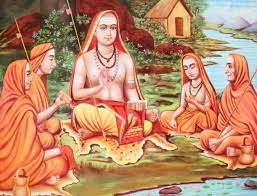UPANISHAD( UP = sitting near NISHAD = the feet of the teacher) again as the beauty of Sanskrit language is the great extant literature of vedant philosophy. The Upanishads are the shining jewels of Indian culture and tradition which needs no introduction. Starting first chronologically Upanishads are part of one of the six orthodox schools of philosophy known as SHATH DARSHAN. It comes under VEDANT (the essence of Vedas) and interestingly apart from various Yoga schools of knowledge it deals with it has stories where sages and scholars continuously interact in form of dialogues and discussions where the basic ideology is that the thirsty pupil approaches
Yoga What are Upanishads: The Guru-Shishya Parmapara
In total there are 24 such divines, spiritual and extremely conclusive stories of heroic scholars, knowledgeable kings and renunciate sages in a plethora of themes and ways. These stories are found in the principle Upanishads, the first and oldest of Upanishads are 11 principle Upanishads. They are as follows:
1. ISHOPANISHAD (ISHA = eternal supreme god)
2. KENOPANISHAD (KEN = that and how)
3. PRASHNOPANISHAD (PRASHN = questions)
4. MUNDAKOPANISHAD (MUNDAKA = as clear as a shaven head)
5. MANDUKYOPANISHAD (MANDUKYA = As still as a FROG (Yoga’s Frog posture)
6. CHHANDOGYOPANSIHAD (CHHANDOGYA = poetic and syllabic)
7. BRIHADARANYAK UPANISHAD (BRIHADARANYAK = Great wilderness of thought)
8. TAITREYA UPANISHAD (TAITREYA = partridge bird)
9. KATHOPANISHAD (KATH = inscribed on a wooden tablet)
10. AITREYOPNISHAD (AITREYA = by AITREYA MAHIDAS, the complier)
11. SHWETASHWATAROPNISHAD (SHWETASHWATAR = bearer of the white horse)
Upanishad tales are the shining gems of universal philosophy while Upanishad establishes the fundamental concepts of ATMA ( true self, the soul), AHAMKAR ( self we know) and PARAMATMA ( the supreme soul).




